
..........................................................................................................................................................................................................
bicycle quickguard

many years ago, in the guardian newspaper, the inestimable matt seaton, now an editor with the new york review of books, wrote a weekly column entitled 'two wheels', in which he examined various aspects of the velocipedinal life, sometimes contentiously, sometimes not. in one of those revered columns, mr seaton brought up the subject of mudguards and their suitability when mounted upon the average road bicycle. there is many a chaingang across the nation that actively frowns upon those who arrive at the grand départ with naked wheels, either relegating them to the nether regions of the peloton, or preventing them from participating altogether.

following my reading of this particular article, i e-mailed mr seaton to protest that, while i understood, in principle, the thrust of his argument in favour of fitting mudguards, i attempted to excuse myself from this regime, by pointing out that horizontal rain and galeforce winds were apt to blow the spray from road tyres in every possible direction. in short, mudguards were about as much use to me as electronic gears on a track bike. you may think that, in this case, i doth protest too much and i confess that i'd be hard pushed to disagree with you.

however, anyone who witnessed the maelstrom that was this year's world championship race in yorkshire, may have noted that mads pedersen crossed the finish line, bereft of mudguards. watch the race highlights if you don't believe me. it was a technical omission that featured across the entire peloton, encouraging the wannabees who enjoy their place in the sunday morning peloton, to follow suit. how can one possibly emulate one's heroes while accessorised with mudguards?
of course, to base my entire disparagement on something as superficial
as hero worship would obviously provide me with little in the way of street
 cred, so more pragmatic refutations would obviously be required. here, there is a veritable plethora of substantiation: rattling, difficult to fit, lack of compatibility with minimal tyre clearance; there's plenty more where those came from. thus, even when chastised by a group of visiting cyclists for riding in the wet, minus any mudguards, my insouciance and total disregard triumphed over practicality.
cred, so more pragmatic refutations would obviously be required. here, there is a veritable plethora of substantiation: rattling, difficult to fit, lack of compatibility with minimal tyre clearance; there's plenty more where those came from. thus, even when chastised by a group of visiting cyclists for riding in the wet, minus any mudguards, my insouciance and total disregard triumphed over practicality.
and then i was sent a pair of quickguards for review.
if there's anything simpler on the market, i'd love to hear about it. presuming a lengthy morning, attempting to decipher inscrutable instructions while failing to install the quickguards, you can imagine both my surprise and delight when fitting a pair took only five minutes. to cut a short story even shorter, you simply remove the nut from the quick-release levers and replace it with a longer version supplied with the guards. once the wheel is securely fixed into the frame, the quickguard slides over the replacement skewer nut, positioned as required, and the allen bolt tightened.
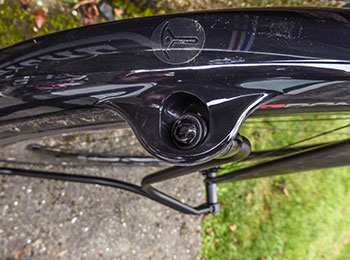
the substantial aluminium stay is affixed to only one side of the quickguard and can be adjusted from side to side on the elongated skewer nut to position it over the tyre. should further adjustment be required to centre the guard, the bolts attaching the guard to the stay can be adjusted laterally. the front guard is fitted behind the fork, preventing spray tarnishing the underside of the downtube and a smart pair of cycle shoes. as sergei would say, "simples".
i have ridden the ritchey over hill and dale, across several cattle grids and along a few of the roads kept only for special occasions.
 i fib not, when i relate that i had forgotten the quickguards were even there. during a bout of frequent rain showers, the peloton were more than happy to ride aft of my wheel without undue cause for complaint, and over the rough, potholed tarmac that passes for hebridean roads, there was nary a rattle to be heard.
i fib not, when i relate that i had forgotten the quickguards were even there. during a bout of frequent rain showers, the peloton were more than happy to ride aft of my wheel without undue cause for complaint, and over the rough, potholed tarmac that passes for hebridean roads, there was nary a rattle to be heard.
if the wheel has to be removed for any reason, such as a puncture, the q/r need only be released in the usual manner; the guard simply detaches with the wheel. it will thus suprise you not that the quickguards will remain aboard the ritchey logic for the remainder of the winter months (i may take them off, come july). if, like me, you have long borne an aversion to mudguards on a road bike, considering them an insurmountable travesty, i'm pretty sure these will provide the perfect antidote.
quickguards are available only in black. the quick release version as described above, retail at a price of £34.99 each, while the thru-axle edition costs £10 more at £44.99. quickguards are distributed in the uk by chicken cycle kit.
monday 18 november 2019
 ..........................................................................................................................................................................................................
..........................................................................................................................................................................................................the (gravel) road to somewhere

islay's largest accommodation provider is the machrie hotel, situated a few kilometres outside the village of port ellen on the low road heading to bowmore. the hotel was originally built in the latter part of the 19th century and partners a world renowned golf course. in the late 20th century, the hotel changed hands several times, with the owners seemingly more concerned about income than investment. ultimately, it lost the battle with the laws of economics, and closed its doors, losing the island a substantial number of bedrooms, needed to satisfy the growing demand generated by an ever-increasing number of distilleries.
the hotel was eventually purchased by baroness sue nye and her husband, gavyn davies, a former bbc chairman and director of goldman sachs bank. they have invested millions on revamping the hotel to an incredibly high standard, in the process, providing the island with a total of 47 rooms, suites and lodges. the hotel also sports a health spa and gym, along with a 30-seat cinema. the latter will show a different christmas movie each day during december up till christmas eve.
you can perhaps gauge the sort of clientele attracted to such luxury, when i tell you that, following last year's office christmas lunch, we emerged to the sight of five helicopters parked on the front lawn. having spent their money on such accommodative luxury, the new owners at least had the savvy to realise that they knew virtually nothing about running an hotel, engaging the services of campbell gray hotels to ensure the projected standards were met to everyone's satisfaction.
the only downside to this happy story is the access road.
machrie hotel is situated over a kilometre off the main road, and is reached by means of a single-track, gravel road, which was reconstituted at great expense last year, yet remains as treacherous as ever it was. i can perhaps paint the ideal picture of this if i tell you it was quicker for me to reach the hotel on my cyclocross bike, than for one of my colleagues driving an suv. for even though the road had been re-gravelled, the hebridean weather soon had it as potholed and rutted as ever it was. rumour has it that the track will eventually receive a coating of tarmac when calmac eventually make space on a car deck for the necessary vehicles.
it is currently, however, hardly the finest example of a potential gravel parcours on which to hold yet another, increasingly popular, gravel event, should we indeed, consider this to be a wizard wheeze.
though the united kingdom is not as well-provided with kilometre after kilometre of gravel, as is north america, i'd be willing to bet that there is still an impressive number of british pedallists considering applying the n+1 formula to a new gravel bike. as our roads become ever more packed with motor cars, the attraction of riding offroad on other than a mountain bike is likely to grow exponentially, and where there's an increasing demand for any genre of cycling, the likelihood of it seeing the advent of organised competition becomes ever greater.
according to recent rumours, the union cycliste internationale, international cycling's governing body, is poised to enter gravel racing in a big way, with rumours circulating of a prospective 2020 gravel gran fondo series, ultimately culminating in a world championship. this would presumably help explain how and why former segafredo-trek road professional, peter stetina, has announced that he is departing world tour road cycling to focus on gravel and ultra-endurance mountain bike racing.
in 2019, stetina mixed his world tour duties with an alternative season of gravel racing and it appears that so doing has but helped him come to this decision. however, i confess my surprise that there are sufficient such events to allow stetina and others to earn a decent living amongst the loose stones and patches of mud. consider, if you will, that women's racing has long struggled to gain acceptance, sponsorship and tv coverage to create a commercially viable segment allowing some competitors, at least, to pay the rent. other than the strade bianche, which remains on the wordl tour calendar, i can think of no other gravel type event that receives major tv coverage. and, as we all know, without exposure on the telly-box, sponsorship, the lifeblood of the majority of sports, is generally very hard to come by.
however, at 32, it seems unlikely that stetina is about to collect his pension for early retirement, so one can only assume that, for a certain minority, there is sufficient income to be gained from speedy scurrying about in the gravel. the jury is out on whether this is to be considered a good thing or not, given the comparative youth of the gravel bike, and whether it intends to stick around for the long haul.
is there really space in the calendar for the similarities between xc mountain biking, cyclocross and gravel racing?
sunday 17 november 2019
 ..........................................................................................................................................................................................................
..........................................................................................................................................................................................................a few words with artist, oliver brookes

being a big artist fish in a small pond is being at primary school. i used to win the majority of art competitions for which i was entered, very much to the chagrin of my fellow pupils. move onto secondary school and i became a big fish in amongst several other big fishes, and the certificates and prizes were a tad harder to come by, even if much of my work gained the approbation of the teachers. however, the latter fact encouraged me to aim for art college, ultimately producing a portfolio of what i regarded as my finest minutes, allied not only to a higher art certificate, but sixth year studies too.
more through total ignorance than supreme confidence, i applied to art college without a plan b, should such application have been subsequently found wanting. thankfully, i was spared such ignominy and embarrassment. it was at that point that the house of cards became shakier than desired, and any thoughts of remaining a big fish were banished for the foreseeable future.

you see, in all the years spent at school, the subject matter was bestowed upon the class by the art teacher. all we had to do in our artistic eagerness, was find ways and means to satisfy such demands. art school, it transpired, required an entirely different approach, one that relied entirely on drawing and painting students seeking their own way in the world of oil and canvas. from a personal point of view, the latter was made somewhat more onerous due to the relegation of watercolours as a media suitable only for sketches and not for the final submitted artwork for assessment.
if you've had precious little experience with oil paint, this could be seen as a problem. and it was.
the bicycle, in the shape of a raleigh-twenty shopping bike, had been left mouldering in the garden shed; art students are way too cool for cycling. it would have been, however, of great artistic solace, had i been as obsessed with bicycles then, as i profess to be nowadays. the velocipede would surely have provided thematic salvation from the scattergun approach that ultimately covered the canvases in my painting rack. the notion of remedying the situation in the present day has occasionally occurred to me, but it remains theoretical, rather than practical.

however, creating art involving watercolour, landscape and bicycles has become the calling card of edinburgh-based designer, come artist, oliver brookes. oddly enough, the above combination is not as common as you'd think, or even hope, in the grand scheme of things, so what or who influenced oliver brookes in his choice of subject matter?
"Paterson (illustration right) used to do it for me in Cycling Weekly back in the 70s, but he was more of a jerkin and saddlebag sort of guy. I wanted to capture the tension of close racing set in my local East Lothian landscape."
the trouble with drawing and painting, if that's a suitable frame of reference, is that you don't see too many ads in the press for artists. but designers? so, despite favouring brushes at college, i, more pragmatically looked towards design as my future means of employment. oliver brookes studied at winchester, bristol and the royal college of art, specialising in design for the past three and a half decades, but has now decided to reveal his inner artist. however, while at college, did he specialise in graphics more than in painting?

"I loved graphics at school. I supported Wolves and QPR (football clubs) just for their colours. Painting crept up on me later on, like a slow cadence minute man."
as i mentioned above, the college i attended would only accept final compositions if painted in either oils or acrylics, applied either to stretched canvas or primed board. we soon relaised that, if the priming was applied to the non-smooth side of hardboard, it offered a more tactile surface on with to apply the medium. watercolours is still, to this day, regarded as the preserve of the amateur, despite being technically more challenging than oil paint. it's a darned sight harder to scrape watercolour paint from stretched paper, than it is with oils. does oliver ever work in oils?
"Watercolours are like sprints; oils are the full Tour of Scotland. I'll need to put in some serious miles before I'm confident with the stiff brushes."

when it came to submitted work for exhibition or assessment, the art student psyche within, determined that appending the words 'mixed media' to any given composition, would surely present us as 'real' artists. oliver brookes embodies this very approach in many of his cycling artworks by screenprinting monochrome groups of cyclists atop his unique take on east of scotland landscapes. are the cyclists from original drawings, or derived from photographs?
"On a training night, I tuck a Go Pro into my jersey, auto-shooting every two seconds, taking it out when things get dramatic. Back home, I sort through the 3600 shots, discarding 3500 close-ups of my pocket."
nomenclature often gets in the way of reality, creating denominations and categories that don't always represent that which they've been designed for. thus there are sculptors, painters, designers, videographers etc., all of whom can be placed under the umbrella of 'artists'. mr brookes' watercolours are undoubtedly the work of an artist, yet the screenprinted cyclists arguably turn the final images into the preserve of the graphic designer. does he make any distinction between 'designer' and 'artist'?

"A domestique, like a designer, sells their creative services to the team manager, while an artist is out of radio contact, free to extemporise and dictate the race plan.
"I like to think of myself as an irascible-obsessive-hybrid; half Cavendish, half Van Gogh"
in his compendium 'one more kilometre and we're in the showers', author tim hilton propounds that cycling is comprised of a greater proportion of artistic individuals than most other groups of individuals. has oliver found this to be so?
"All cyclists are righteous and good, except Lance"
on reaching the home-page of oliver brooke, you're met with an attractive image, the centrepiece of which is a road bicycle, probably depicting his cinelli estrada pro, described in a sub-menu, as comprising matt black carbon with wishbone seatstays. would this indicate that oliver is more in thrall to carbon than steel?
"Men obsess all their lives about what they couldn't attain when they were 18. In torpid middle-age, they fight off the dimming of the light by trying to buy back their prime years with overpriced retro nonsense. I love new kit and try to face forwards not back."
i have a few friends who are professional photographers, chaps who are never to be found without a camera about their person, whether a compact digital or one of those all singing, all dancing mirrorless doohickies. and they're not shy of using them, snapping images at every opportunity. i, on the other hand, frequently have a camera in one of the three rear pockets, but the internal debates over whether i ought to interrupt a bike ride to snap a photo, almost always result in the continuation of pedalling.
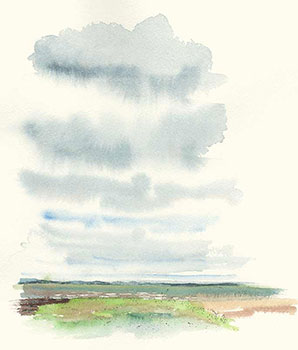
does oliver find moments, when sat in his toyota yaris, composing yet another masterpiece, that really, he'd rather be out on the bike?
"No. Painting is just as obsessive and absorbing as going flat out in the bunch, right on the rivet."
modern society delights in progress. the art of standing still for any appreciable length of time is currently persona non grata. but essentially, there's nothing wrong with reaching a particular level in an artistic career, and deciding to sit there. john lowry morrison is an excellent example of this, even if comparisons with status quo are hardly too far from the mark. but surely at least a part of the joy of being an artist, is continually striving for what ultimately might be termed the unattainable.
does oliver have a specific aim in his career as an artist, or is he simply happy to be making images as he sees fit?
"Wouldn't it be great if you could draw as smoothly and intuitively as you ride through a cambered downhill curve? That's my ambition."
oliver's singularly inventive art can be seen and purchased from his website oliverbrookes.co.uk
saturday 16 november 2019
 ..........................................................................................................................................................................................................
..........................................................................................................................................................................................................finding your way

once upon a time, in a galaxy far, far away, i formed the third leg of a trio, booked to play a night club in the depths of what we shall call ayrshire. my two musical colleagues for the evening were father and son, the latter playing bass guitar and the former ensconced behind an electric organ. we dutifully played our wide selection of tunes while those in front of us dined heartily on the fine repast that preceded the evening's principal cabaret entertainment. first set over and done with, we retired to a back room to scoff the victuals conveniently provided as part of the deal.

while tucking into a veritable plateful, an unrecognised chap stuck his head round the door and enquired as to which one of us was the drummer. affirming that i was the fellow he was looking for, he handed me a sheaf of music and informed that these were my parts for the cabaret accompaniment. it does me no credit whatsoever to confess that i had a) been unaware i was required to fulfil this percussive role, and b), i couldn't read music. still being somewhat green about the gills when it came to the expectations of the music community, i had not the chutzpah to admit to this 'musical director' that the dots written upon the pages were as much use to me at that time, as would have been a food mixer.
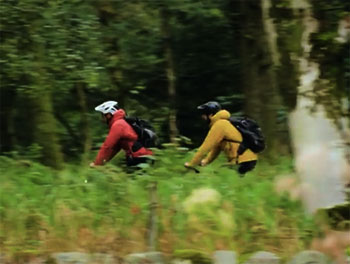
to cut a long story short and get quickly to the happy ending, i simply sat the music on the provided stand, looked intently at it throughout the gig, but simply played what i thought was appropriate to the song. figuring i would be vehemently admonished by the singer, musical director or both, on the contrary, they both expressed themselves more than satisfied with my accompaniments and took a note of my telephone number. concerned that this situation might re-occur sooner, rather than later, i took it upon myself to become better acquainted with written music for the drumset.
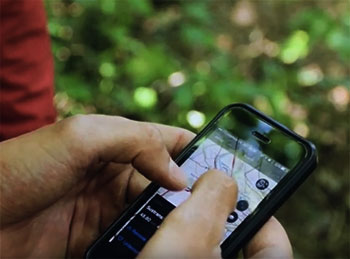
sadly, the same cannot be said about my ability to read maps. i have been aware of this failing, ever since my first cycle trip towards the isle of arran. on disembarking the islay ferry, the intrepid cyclist takes a right on exiting the ferry terminal before veering left but a few hundred metres along the main campbeltown road. to the unwary, non map reader, the ensuing 14% upward gradient will come as an unexpected surprise. those who can read maps will have already dropped into the granny gear prior to the two-kilometre ascent.
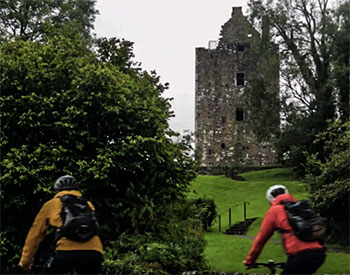
the commonality between the two examples presented above is frequency of use. i have had to substantially revisit my music-reading skills over the past few years as i now teach drumset at the local secondary school. map reading, by and large is still an unnecessary skill as far as i'm concerned, mostly because i rarely venture far enough for it to prove necessary. but with the collaboration between ordnance survey maps and sustrans, there's every encouragement to change such myopic behaviour.
it is not so very long ago since i made mention of the above collaboration, coinciding with greater promotion of the national cycle network and the opportunity to access route maps via the os app. and to further promote the delights to be found along the way, sustrans has joined forces with trail unknown to offer three videos. according to sustrans' experience director (?) stephen davies "57% of the population live within a mile of their nearest route, so we hope these short videos inspire more people to get out and discover all that the Network has to offer - whether that's on wheels or on foot."

even though i'm one of the 43% living nowhere near a sustrans route, the combination of the incredible scenery displayed in these videos, coupled with the ability to not only access the routes on os maps, but download them to use offline, is a prime example of clever thinking. sustrans offer this as a means of circumventing a lack of a viable mobile signal, but in the case of yours truly, i have only an ipod touch to fulfil that need.
the weather at present perhaps precludes lengthy trips through the countryside, but there's nothing better than sitting by the central heating, planning next spring or summer's cycle-trip, avoiding the inquities and dangers of riding in traffic. the video links can be found below. the os app can be found on apple's app store, or on googleplay
carlisle to glasgow | braunton to meath - the tarka trail | wye dale to bakewell - monsal trail
friday 15 november 2019
 ..........................................................................................................................................................................................................
..........................................................................................................................................................................................................wall paper

on my first visit to rapha's original imperial works, a former piano factory in kentish town, a building with truckloads more character than the current version near kings cross station, there were very few individuals occupying the space, overlooking the railway, leading from the overground station nearby. founder and managing director (before becoming chief executive officer) had a desk in the left corner, bordered on one side by the aptly named 'wall of pain'.
aside from items of artwork describing prospective clothing ideas, there were several images of riders and jerseys from the past, along with prototype press adverts, some of which were quite humorous. i never quite found out whether the large quantity of paraphernalia pinned to the wall was entirely the choice of mr mottram, or whether these were a collective collection of cycle-related imagery.
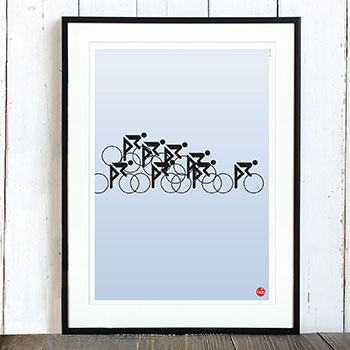
the idea of pinning posters to a wall, however, predominantly walls that constituting teenagers' bedrooms, is not unheard of. as a teenager, i had yet to discover the joys of the velocipede, other than as a vehicle on which to deliver newspaper each and every morning. like many, though i confess my memory is a bit dim on such matters, my side of the bedroom featured one or two images of progressive rock bands (those who rarely played anything in 4/4), while my brother's end of the equation was more accustomed to little known football players.
disappointingly, i am now at the stage of life when mrs washingmachinepost holds sway over internal wall decorations, even though it is seemingly ok to own an exterior projector, capable of beaming brightly-coloured, moving christmas images all across the front of the croft. the framed last vestiges of my career as an artist dominate the walls of our living quarters, if only because there was nowhere else to put them. therefore any spurious augmentation of said paintings must also be framed.

which reminds me, i've yet to hang my framed photograph of gene krupa.
other than two very small monochrome promotional images, gleaned from the days of rapha's 'wall of pain', there is an embarrassing dearth of cycle-related imagery in the downstairs living quarters. upstairs, is an entirely different bucket of derailleurs, where pride of place has been given over to a framed wool peugeot jersey, presented by prendas, and signed by robert millar. facing the jersey, is a superb caricature of marco pantani. notwithstanding the last two items of framed finery, the quality of cycling art and design has improved dramatically over the past few years, currently culminating in the latest offering from t-labs.

well-known for their wide range of cleverly designed t-shirts, several of which have been reviewed in these very pixels, t-labs have produced a range of posters of appeal to the international peloton. displaying quality graphic design imagery describing paris-roubaix, the stelvio pass, an intriguing peloton and the ventoux amongst others. these are available as a3 digital prints on 230gsm matt art paper, framed (£42) or unframed (£26). personally, i have no option; there's no way mrs washingmachinepost is going to allow a drawing-pinned cycling poster on the bedroom wall, no matter its superlative graphic superiority.
and just in case it had escaped your attention in the miasma engendered by brexit and a december general election, christmas will be along a darned sight sooner than you might think. one (or the entire selection) would surely be the ideal festive present for that special cyclist in your life, even if that special cyclist is you. the link below will enlighten you further.
thursday 14 november 2019
 ..........................................................................................................................................................................................................
..........................................................................................................................................................................................................confusion reigns

in one of the more relevant features from last saturday evening's track racing in chris hoy's private velodrome, the unknown (or unrecognised) lady track rider spoke to the uci's head commissaire for the evening. among the questions asked, was the poignant "what are the ipads for?", the answer alluding to the uci's now regulatory quest for hidden motors in the bicycle frames. i was also able to learn that the minimum weight for a track bike is precisely the same (6.8kg) as determines that of competitive road bikes. mentally, i was asking myself "why?"
but, to return to the quest for hidden motors, perhaps track bikes are best placed to conceal such devices, given the recent predilection for including the motors for e-road bikes within the rear hub. with the number of carbon disc wheels on display both on track and the infield, all that carbon fibre would surely help hide an ill-judged and illegal armature? however, the one part that i fail to understand, when searching for such illicit devices, is just of what possible use such a motor could possibly be?

when several of the competing sprinters were seemingly capable of reaching speeds of over 70 kph, an electric motor that, at best, could push to a highly illegal 48kph, wouldn't appear to be of much use. those last 22 kilometres would have had need of being achieved on a bicycle carrying an electric motor contributing nothing whatsoever to a race-winning speed. which is where, by association, my second bout of confusion arrives.
earlier this week, cycle sponsor of ef education first, cannondale, announced the release of their latest e-road bike, a burgeoning category that, to me at least, makes no sense at all. just like those hypothetically illegal track bikes, with non-existent motors not hidden in their carbon disc wheels, the cannondale supersix evo-neo, features a road legal electric motor on the rear hub. this is a location that has already created division amongst those who, for no reason that i can fathom, consider themselves potential e-road bike customers. though a battery is concealed within the svelte carbon frame, purchasers are pretty much stuck with the factory-supplied wheels.

no doubt, should the market increase to satisfactory proportions, it will spawn an industry of after-market powered wheels, enabling the acquisitive to upgrade to their electrons of choice. such seems to be the way of the world. however, that part at least, makes some degree of sense, but cannondale's promotional explanation (and they're not alone in this) makes little sense.
cannondale's ebikemotion system features the previously mentioned 250w rear hub motor, accessorised with a frame-mounted 250wh battery. this allows the bicycle to offer electric support up to 25kph in the uk and a slightly more enterprising 20mph (32kph) in north america. so far, so normal. however, cannondale's reasoning behind fitting the motor in the rear hub, is the ability to retain airfoil tube shapes capable of generating up to 30% less drag than a standard bicycle frame.
in support of this particular innovation, cannondale design engineer, nathan barry explained that reducing the drag apparently has a sizeable effect on both speed and performance, a factor that is every bit as applicable to e-bikes as it is to the analogue variety. the incomprehensible part, as far as i'm concerned, is barry's statement that the reduction in drag makes it easier to go faster, "especially once riders go above the assitance threshold' (my italics).

the cannondale supersix evo-neo weighs an impressively light 11.3kg, but that's still almost 25lbs in old money. perhaps mistakenly, i had always equated e-road bikes with those less physically capable than the average roadie, allowing them to join in the sunday ride without falling too far behind. however, if one such e-rider has the ability to persistently ride an 11kg bicycle at more than 25kph, what on earth did they need with the motor-assist in the first place? it concerns me that manufacturers such as cannondale would spend substantial amounts of research and development dollars attempting to reduce the drag co-efficiency of a frame that will rarely reach the sort of speeds it's unlikely to be ridden at in the first place.
unless the uci has clandestine plans to create an e-bike world tour in the near future, this particular category of bicycle has me completely and utterly confounded.
cannondale evo neo e-road bike
wednesday 13 november 2019
 ..........................................................................................................................................................................................................
..........................................................................................................................................................................................................abnormal?

i have persistently moaned about the lack of consistency experienced with hebridean weather. according to annual rainfall statistics, the west of scotland is one of the wettest parts of europe, yet try as i might, i cannot corral enough of that precipitation to aid in reviewing a brace of waterproof jackets, much to the delight of mrs washingmachinepost and my work colleagues. you would be right to accusingly point the finger in my direction, making it plain that saturday morning was impressively wet and windy to the extent of making a ferry trip to scotland considerably less smooth than it was on the return sailing. but, as you might infer from my last sentence, while the weather raged on islay, i was off to glasgow to watch track-racing in oppressive heat.
as mentioned, the return sailing was over a part of the ocean, under clear blue skies, that resembled the proverbial millpond. yet, but a few hours after my arrival on island soil, the clouds gathered and drowned most of the evening, the very part of the darkened day when bike riding was not uppermost in my mind. sadly, as a result of this inclement procrastination, those jackets remain on the hanger, unsullied by even the smallest water droplet, as i close in on having to apologise to the respective apparel providers for a lack of published exposure.
granted, i am incredibly thankful that islay has not been exposed to the flooding suffered by those in middle england, but once again, yesterday morning dawned to the sound of galeforce winds, and driving rain, while the temperature remained defensively in single digits. you would think that, after an opening like that, there would be cheering and bunting in the twmp household, yet celebrations were muted with the knowledge that the morning was earmarked for a specsavers appointment.
islay once had a resident optician (or, opthalmologist, as charlie brown would have it), an amiable fellow who sadly passed away a few years ago. his replacement seems only to work intermittently, and he refuses to advertise when those intermittent periods might be. fortunately, specsavers pay frequent visits to the hebrides, hence the appointment fulfillment that filled the bulk of my morning.
there was, however, a modest amount of cycling required to realise the appointment, undertaken in the weather conditions outlined above, but scarcely for long enough in which to judge the efficacy of breathable waterproofing, particularly when both garments are of race-fit constitution. however, the one unexpected factor that accompanied my visit to the opthalmologist, was the all but uncomprehending aspect of my arrival.
i have lived on islay for just over thirty-two years, during which time i have constantly ridden my bicycle to all corners of the isle. in the early years, i was effectively the sole cyclist within a population of marginally above 3,000 people. yet, as i entered the building, clad in a waterproof jacket, waterproof trousers, cycling shoes, cycling cap and a bright orange specialized helmet, i was greeted with the self evident question, "you didn't cycle out here, did you? 'out here', was barely a mile from the croft, reached with a tailwind and during a lull between showers of rain. and as if to rub salt in the wound, the question was asked more than once.
with halfords recently announcing bicycle sales growth, a sunday peloton that has shown an appreciable increase over the last decade and bicycle racks featured in bowmore main street, i was under the apparent misapprehension that cycling had become a tad more mainstream. aside from which, on pretty much every other day of the week, someone will always ask why i'm not out on the bike. believe it or not, i was asked that very question but an hour or so after returning from my eye appointment.
in this day and age, why is it still worthy of remark that travel can, and is, undertaken on two wheels, even in less than pristine weather conditions? not to place too serious a spin on such matters, surely a man or woman on a bicycle ought to have reached the status of commonality? just when i thought that my work here was done.
tuesday 12 november 2019
 ..........................................................................................................................................................................................................
..........................................................................................................................................................................................................